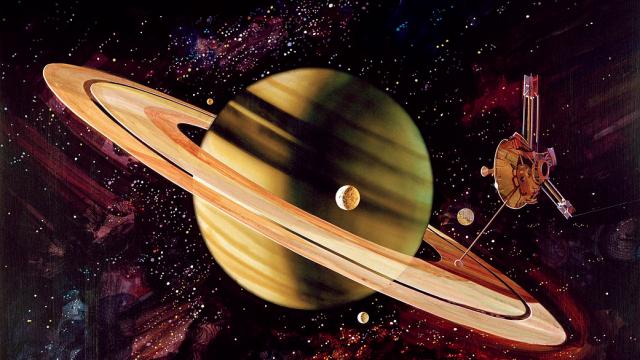It’s an orgy of geometry, here on Earth. You got all kinds of shapes: Squares, trapezoids, even the occasional rhombus. Apples, desk-chairs, and dandelions – just an abundance of shape-having stuff. Outer space, in contrast, is minimally decorated: asteroids, stars, planets, galaxies. Big-picture stuff. We know the Earth is round – or, at least, most of us do – but what about the other stuff? What shapes are twirling around up there, and why do they look like that?
For this week’s Pioneer 11, launched 45 years ago on April 5, 1973, became the first human-made object to fly past Saturn.
Meredith Hughes
Assistant Professor, Astronomy, Wesleyan University
Planetary systems like ours are flat, with planets orbiting around in concentric orbits all going the same direction rather than buzzing around like bees in a hive.
Star and planet formation happens when dense pieces of molecular clouds collapse under the influence of gravity — essentially, when they become dense enough that gravity can overcome the cloud’s natural pressure. Molecular clouds are wreathing, smoky mixtures of gas and dust spread throughout our galaxy, and the collapse isolates one part of the cloud and shrinks it down to a relatively tiny size. That process of taking something that is slowly wreathing on large scales and shrinking it is exactly like what happens when a figure skater starts a slow spin and then pulls in her arms: the closer her arms get to her body, the faster she spins. The smaller the cloud gets, the faster it spins.
At that point, you have gravity being sticky and pulling things together, and you have angular momentum causing a major spin. Another situation in which you have a sticky substance that starts to spin is something you have probably done in your own kitchen: making a pizza. In a collapsing cloud, just like when you spin sticky pizza dough, the combination of spin and stickiness flattens the material into a disk- or pizza-like shape. We call these disks of leftover cloud material orbiting around young stars “protoplanetary disks,” because that leftover material from the cloud forms the building blocks for planets that will eventually orbit the star. Since the material starts off in a disk, which has a preferred plane and spin direction, the planets that form out of the disk generally retain that flat shape and the same spin direction – both in terms of which way they orbit around the star, and in terms of how they orbit on their axis. That’s why, when you look at orbits in the Solar System, all of the planets are located in a fairly flat plane, they all orbit the Sun in the same direction, and almost all of them rotate on their axes in the same direction (Venus and Uranus are the two exceptions – we think they got smacked by some other large body shortly after they formed that knocked them a bit off-kilter). This is an old idea, dating back to Kant and Laplace, but it’s one of the fundamental insights that forms the basis of our modern-day understanding of the planet formation process.
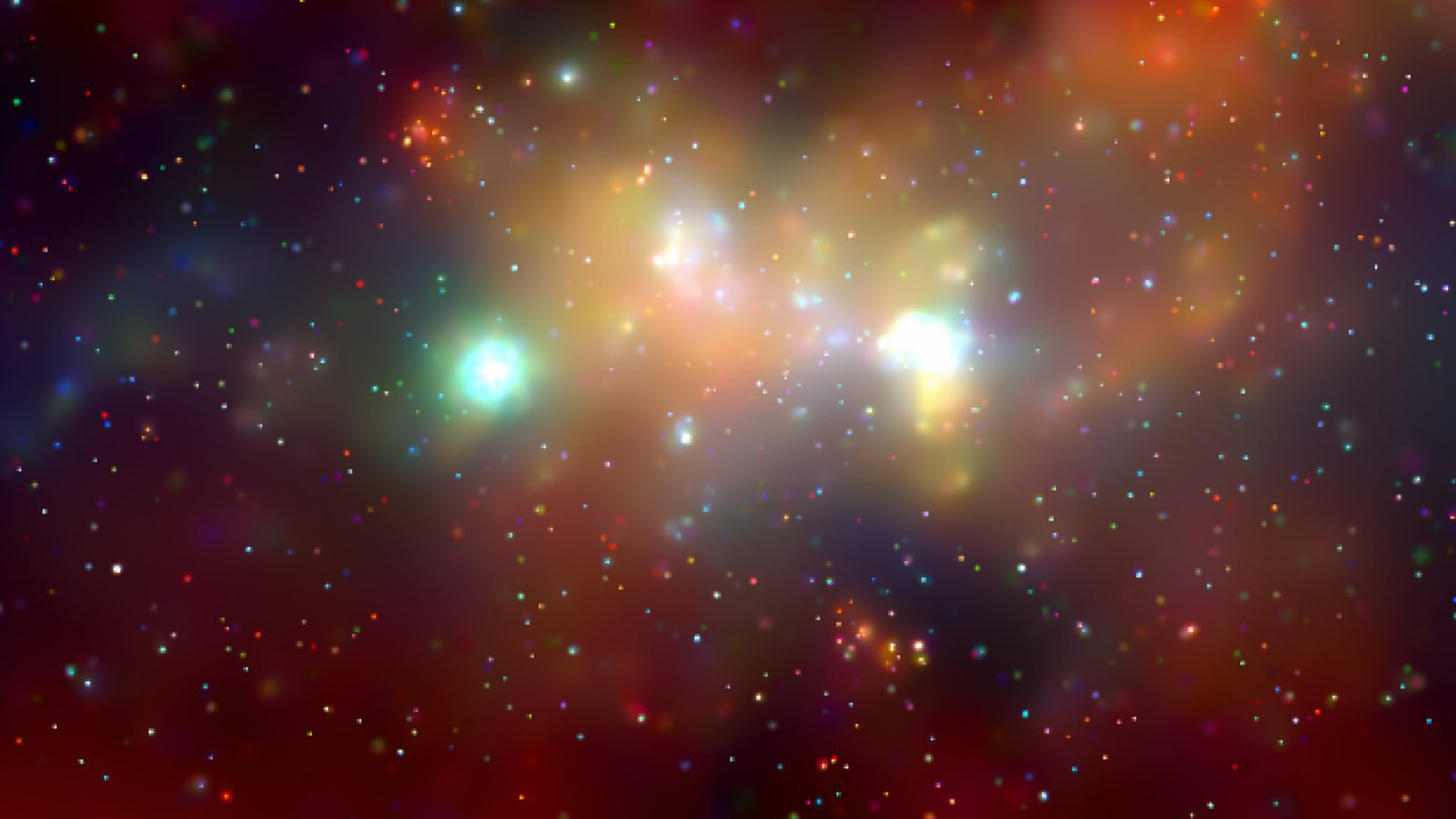
This 400 by 900 light-year mosaic of several Chandra images of the central region of our Milky Way galaxy reveals hundreds of white dwarf stars, neutron stars, and black holes bathed in an incandescent fog of multimillion-degree gas.
Richard Townsend
Associate Professor, Astronomy, University of Wisconsin-Madison
Most things in space – in particular, stars, planets, black holes and large asteroids – are spherical in shape, like a basketball. This is because the dominant force at the immense scales in space is gravity. For any sufficiently massive object, self-gravity – the gravitational pull of each part of the object on the other parts of the same object — tends to mould the object into the most compact form, and that happens to be a sphere. There are a couple of exceptions to this rule, however. If the mass of the object is not big enough to generate significant self-gravity, then other forces – for instance, structural forces arising from the rigid nature of solid matter – can counteract the gravity and produce a more complex shape. This is the reason why smaller asteroids, and also comets, are often not spherical; an example here is comet 67P/Churyumov-Gerasimenko, which was revealed by the Rosetta probe to have a peculiar rubber-duck shape. It’s also the reason why humans are not spherical!
Another exception arises if the object is rapidly spinning. Then, inertial effects from the rotation (what we think of as the ‘centrifugal force’ in everyday life) counteract the gravitational force in directions perpendicular to the rotation axis. This often results in an ‘oblate spheroid’ shape similar to M&M candy, or a disk-like shape. We can see the former in our own solar system: Jupiter and Saturn both spin rapidly with a rotation period close to 10 hours, and both are oblate spheroids rather than spheres. Likewise, the latter can be seen in the structure of many galaxies, including our own Milky Way (the appearance of the Milky Way, as a band of diffuse light on the night sky, is because we’re embedded inside the disk).
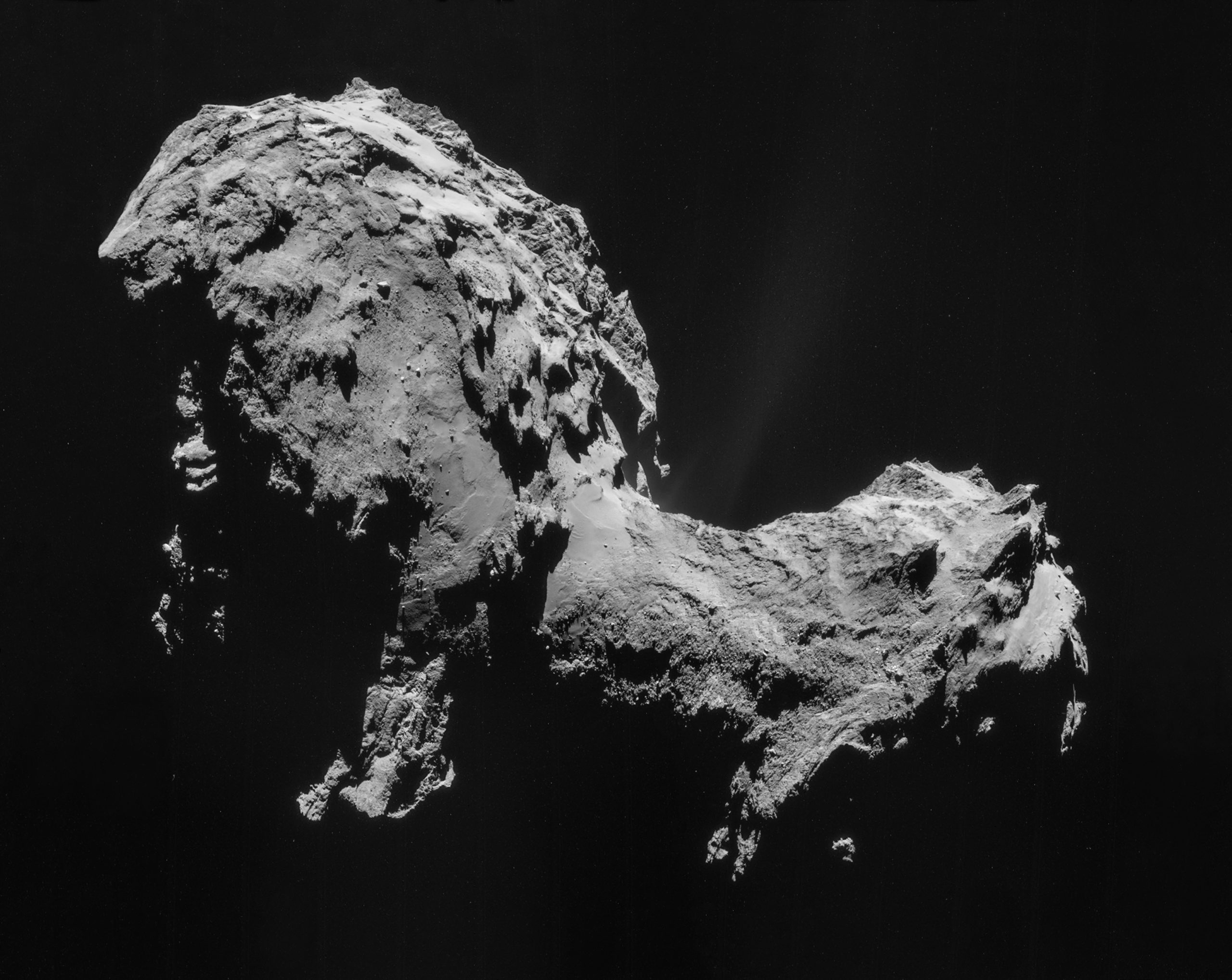
Comet 67P/Churyumov-Gerasimenko via the Rosetta probe, and its weird shape.
Jonathan Levine
Associate Professor, Physics, Colgate University
Many objects in space, like stars and planets, are quite nearly spheres. The sphere is the shape with the greatest symmetry; it’s no different in one direction than any other. Stars take this shape because the gravity pulling themselves together finds an equilibrium with the pressure of their hot gas pushing themselves outward. Both gravity and pressure are isotropic, meaning that they too are symmetric, and have no reason to prefer one direction over another. The sphere’s symmetry is demanded by the symmetry of the two balanced symmetric forces.
Earth is almost a sphere as well, but in Earth’s case the gravity that would tend to compact it is opposed by the strength of rock and water, rather than the pressure of hot gas as in the Sun. Still, the material strength of Earth’s constituents are nearly isotropic as well, so our planet is quite nearly spherical.
I say “almost” and “quite nearly” because many objects in space, from planets to galaxies, are partly flattened because of their rotation. Earth spins on its axis every day, so in addition to gravity and material strength, there is also a tendency for material to be flung outward, away from the spin axis, and to accumulate in the body’s equator plane. For this reason, Earth is about a dozen miles wider at the hips than it is tall. For Saturn, with its lower density and faster spin, the difference between its width and height is more like 15%. The Milky Way, for its part, is nearly 100 times wider than it is tall. In all cases, the spin breaks the symmetry between one direction (the axis of rotation) and all others.
Pedants might quibble about my saying that material tends to be flung outward while spinning, since this statement smacks of centrifugal forces, which their physics teachers assured them did not exist. However, these people can thank me (and centrifugal force) next time they eat pizza, rather than a saucy cheesy dough-ball.
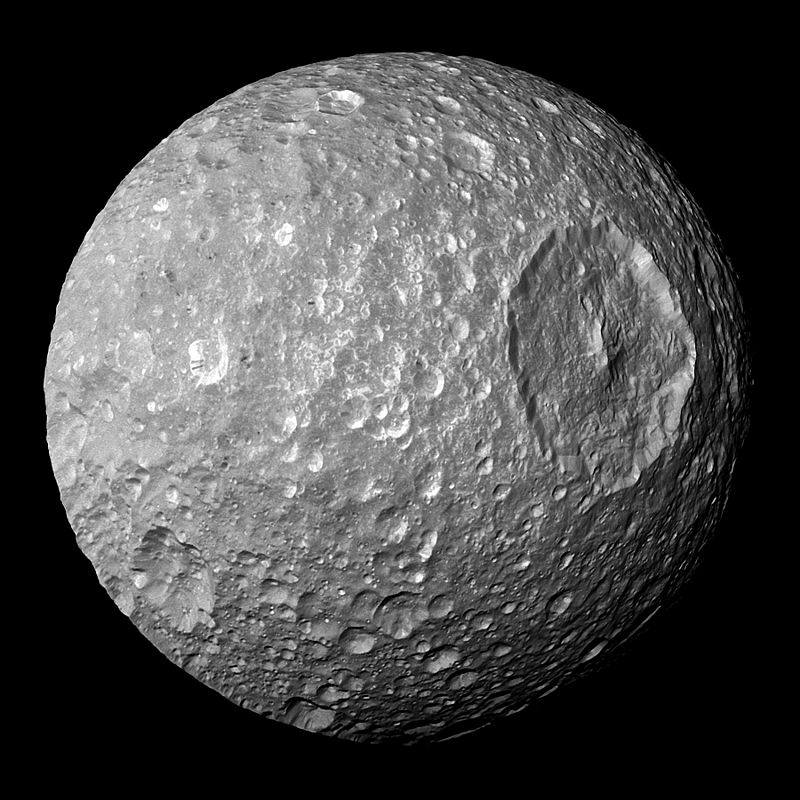
In this view captured by NASA’s Cassini spacecraft on its closest-ever flyby of Saturn’s moon Mimas, large Herschel Crater dominates Mimas, making the moon look like the Death Star in the movie “Star Wars.”
Leslie Rogers
Assistant Professor, Astronomy and Astrophysics, University of Chicago
If an asteroid, moon, or planet is sufficiently massive, the force of its own gravity will be large enough to overcome the strength of the material from which the body is made, and the asteroid/moon/planet will be pulled into a rounded, nearly-spherical shape. Bodies made of rocky material will be gravitationally rounded if they’re larger than about ~450km in radius, while bodies made of weaker icy material will be pulled into a rounded shape if they’re larger than about ~200km in radius. Mimas, the “Death Star lookalike” moon of Saturn, is the smallest known gravitationally rounded body in the Solar System, having a radius of 198 km.
In fact, one of the requirements for a body in the Solar System to be defined a planet (according to the 2006 International Astronomical Union definition) is that it has sufficient mass to assume hydrostatic equilibrium (a nearly round shape).
Gravity would cause an isolated, non-rotating massive body to take on the shape of sphere. If the asteroid/moon/planet is rotating, it will take on the shape of an oblate ellipsoid that is flattened along the poles and bulges out at the equator. Due to rotational flattening, the radius of the Earth at the Equator is 21km larger than the radius of the Earth at the poles. Saturn is the most oblate planet in the Solar System, with its equatorial and polar radii differing by nearly 10%.
The presence of another mass (e.g., a star or a satellite) can also distort the shape of a planetary body due to tides. Because the force of gravity is stronger the closer one gets to a gravitating mass, the side of a planet that is closest to the other mass will feel a stronger gravitational pull than the most distant side. This has the effect of stretching the planet along the direction toward the other mass (star or satellite). It is tidal bulges on the Earth induced by the gravitational pull of the Moon that lead to the twice daily rise and fall of the ocean tides (which are especially prominent in the Bay of Fundy, near my hometown in Nova Scotia).
Pauline Bamby
Associate Professor, Physics and Astronomy, Western University
The shapes of things in space are due to competition between gravity, which wants to bring matter together; pressure, which wants to push matter apart, and rotation, which causes special directions within an object to be important.
Planets and stars are close to being spheres. All the matter within them exerts a gravitational pull on all the other matter, and the most efficient way to get the stuff as close together as possible is to arrange it in a sphere. Why doesn’t the gravity pull so hard that stars and planets collapse into smaller and smaller spheres and become a black hole? Because when the atoms within get close enough together, they push back against each other. That push back is another one reason planets aren’t quite spherical – the Earth isn’t perfectly smooth because the crust sticks together or folds up to make continents. The other reason planets and stars aren’t quite spherical is that they rotate: this squashes them a little so that they are fatter around the equator. For the Earth this results in a tiny difference between its radius at the poles and at the equator of about 0.2%; for other planets and some stars this difference can be much larger – about 10% for Saturn.
One of the ways we define an object as a planet is that its gravity pulls it into a sphere. The largest asteroids, like Vesta and Ceres, are also nearly-spherical. But smaller, “minor planets,” can be quite oddly-shaped, like anything from potatoes to footballs to dog bones. These shapes can depend on what the asteroid is made of and whether it has collided with other asteroids.
Galaxies are a slightly different story from stars and planets. Galaxies are so big that, unlike the atoms in a star, the stars inside a galaxy don’t generally get very close to one another. Gravity and the orbits of stars determine galaxies’ shapes, but getting to a final shape takes a very long time because the distances are so large. Left to their own devices, galaxies can be nearly-spherical, like planets and stars, or highly-flattened due to rotation – our Milky Way is one of these flattened spiral galaxies. Because they are so big, galaxies are more likely than stars or planets to collide! When galaxies get close to each other, their mutual gravity can pull out long tails or shells of stars and gas from their outskirts. If the galaxies are moving slowly enough to eventually merge, their shapes become quite lumpy and distorted – we affectionately call these “train wrecks” – until millions of years pass and gravity smooths everything out.
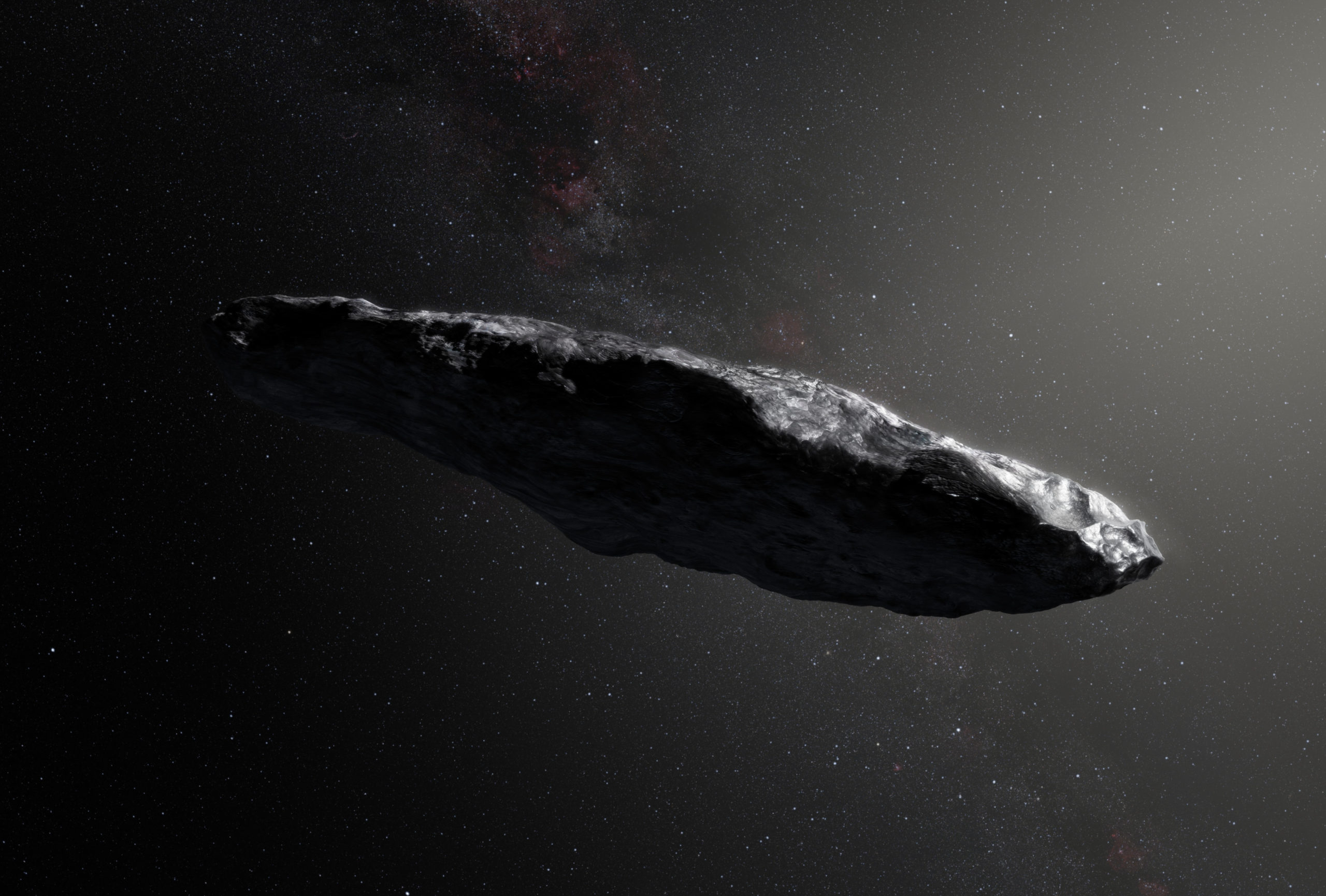
An illustration of ‘Oumuamua, the first object we’ve ever seen pass through our own solar system that has interstellar origins.
Rachel Bezanson
Observational Astronomer, University of Pittsburgh
Galaxies in the nearby Universe come in two basic types: flattened disk-like spirals, like our Milky Way, and rounder, more spherical, elliptical galaxies. Spiral galaxies will often have a nearly spherical bulge in the center such that their overall shapes would closely resemble two sunny-side up eggs pasted together on their flat edges. If you rank-order galaxies by the ratio of bulge to disk size, eventually you start to find galaxies with no obvious disk at all — which we call elliptical galaxies. These galaxies are rarely perfectly spherical, but are often “oblate spheroids,” or hamburger-shaped, with one axis slightly shorter than the others.
Of course, when we see galaxies in the sky, we see them projected onto 2-dimensions, so depending on the angle from which we are looking, we can see spiral galaxies as anything from very narrow lines, possibly with a round bulge, if we see them edge-on to perfectly circular if they are face-on. Elliptical galaxies will also exhibit a range of projected elongations (from fairly narrow ellipses to circles), but will be rounder on average than spiral galaxies.
In general, the shapes of galaxies reflect the orbits of the stars racing around inside of them. If you have many stars orbiting in an ordered fashion in the same plane, their paths will trace out a thin disk, like the disks found in spiral galaxies. Any time you have significant populations of stars that trace out orbits in a different plane those random motions will start to create rounder, more spherical shapes in three dimensions. These random or non-planar orbits are found in the round bulges of spiral galaxies and in elliptical galaxies. We think that most stars in the Universe form in disk-like structures, therefore all random orbits – and therefore rounder shapes – that we observe are caused by galaxy interactions and collisions. Therefore determining the shape of galaxies and the nature of their stellar orbits are instrumental to understanding their cosmic history.
